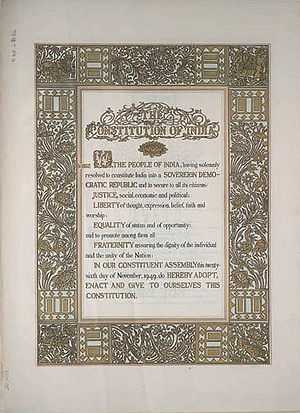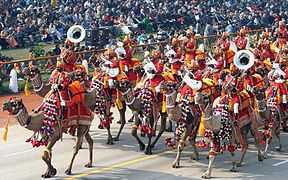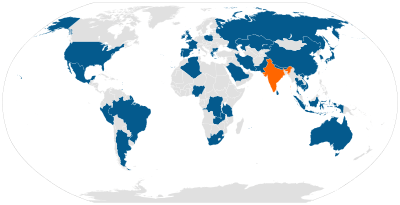Republic Day (India)
| Republic Day | |
|---|---|
 The original text of the Preamble to the Constitution of India. The Constitution of India came into force on 26 January, 1950. | |
| Observed by | India, Asia |
| Type | National |
| Celebrations | Parades, distribution of sweets in schools and cultural dances |
| Begins | 26 January |
| Ends | 14 February |
| Date | 26 January |
| Next time | 26 January 2016 |
| Frequency | Annual |
Republic Day honors the date on which the Constitution of India came into force on 26 January, 1950 replacing the Government of India Act (1935) as the governing document of India.[1]
The Constitution was passed by the Constituent Assembly of India on 26 November 1949 but was adopted on 26 January 1950 with a democratic government system, completing the country's transition toward becoming an independent republic. 26 January was selected for this purpose because it was this day in 1930 when the Declaration of Indian Independence (Purna Swaraj) was proclaimed by the Indian National Congress.
It is one of three national holidays in India, the other two being Independence Day and Gandhi Jayanti.
History

India achieved independence from British rule on 15 August 1947 following the Indian independence movement noted for largely peaceful nonviolent resistance and civil disobedience led by Mahatma Gandhi. The independence came through the Indian Independence Act 1947 (10 & 11 Geo 6 c 30), an Act of the Parliament of the United Kingdom that partitioned British India into the two new independent Dominions of the British Commonwealth (later Commonwealth of Nations): India and Pakistan.[2] India obtained its independence on 15 August 1947 as a constitutional monarchy with George VI as head of state and the Earl Mountbatten as governor-general. The country, though, did not yet have a permanent constitution; instead its laws were based on the modified colonial Government of India Act 1935. On 28 August 1947, the Drafting Committee was appointed to draft a permanent constitution, with Dr B R Ambedkar as chairman. While India's Independence Day celebrates its freedom from British Rule, the Republic Day celebrates of coming into force of its constitution. A draft constitution was prepared by the committee and submitted to the Assembly on 4 November 1947.[3] The Assembly met, in sessions open to public, for 166 days, spread over a period of 2 years, 11 months and 18 days before adopting the Constitution. After many deliberations and some modifications, the 308 members of the Assembly signed two hand-written copies of the document (one each in Hindi and English) on 24 January 1950. Two days later, it came into effect throughout the nation.
Celebrations
The main Republic Day celebration is held in the national capital, New Delhi, at the Rajpath before the President of India. On this day, ceremonious parades take place at the Rajpath, which are performed as a tribute to India.
In 2014, on the occasion of the 65th Republic Day, the Protocol Department of the Government of Maharashtra held its first parade on the lines of the Delhi Republic Day parade along the entire stretch of Marine Drive in Mumbai. India, celebrated 66th republic day on 26th January, 2015 with great pride and honor and invited 44th president of United States, Barack Obama as a chief guest for the prestigious republic day parade.[4]
Delhi Republic Day parade
Delhi Republic Day parade is held in the capital, New Delhi, from the Raisina Hill near the Rashtrapati Bhavan (the President's residence), along the Rajpath, past India Gate.[5] Prior to its commencement, the Prime Minister lays a floral wreath at the Amar Jawan Jyoti, a memorial to martyred soldiers at the India Gate at one end of Rajpath, which is followed by two minutes silence in the memory of them. It is a solemn reminder of the sacrifice of the martyrs who died for the country in the freedom movement and the succeeding wars for the defence of sovereignty of their country. Thereafter he/she reaches the main dais at Rajpath to join other dignitaries, subsequently the President arrives along with the chief guest of the occasion. They are escorted on horseback.
Beating Retreat
The Beating Retreat ceremony is held after officially denoting the end of Republic Day festivities. It is conducted on the evening of 29 January, the third day after the Republic Day. It is performed by the bands of the three wings of the military, the Indian Army, Indian Navy and Indian Air Force. The venue is Raisina Hills and an adjacent square, Vijay Chowk, flanked by the North and South block of the Rashtrapati Bhavan (President's Palace) towards the end of Rajpath.
The Chief Guest of the function is the President of India who arrives escorted by the (PBG), a cavalry unit. When the President arrives, the PBG commander asks the unit to give the National Salute, which is followed by the playing of the Indian National Anthem, Jana Gana Mana, by the Army. The Army develops the ceremony of display by the massed bands in which Military Bands, Pipe and Drum Bands, Buglers and Trumpeters from various Army Regiments besides bands from the Navy and Air Force take part which play popular tunes like Abide With Me, Mahatma Gandhi's favourite hymn, and Saare Jahan Se Achcha at the end.[6][7][8]
Gallery
-

Rashtrapati Bhavan been lit up.
-

Soldiers at the Republic day parade 2013 at New Delhi.
-

Agni-V missile and Pinaka multi barrel rocket launcher at the Republic day parade 2013.
-

Surya Kiran Aerobatics Team displaying tricolor.
-

Border Security Force personnel on Republic Day.
Chief guest

Since 1950, India has been hosting head of state or government of another country as the state guest of honour for Republic Day celebrations in New Delhi. During 1950-1954, Republic Day celebrations were organised at different venues (like Irwin Stadium, Kingsway, Red Fort and Ramlila Grounds).[9] It was only starting 1955 when the parade in its present form was organised at Rajpath.[9] The guest country is chosen after a deliberation of strategic, economic and political interests. During 1950s-1970s, a number of NAM and Eastern Bloc countries were hosted by India. In the post-Cold War era, India has also invited several Western leaders on a state visit during the Republic Day. It is notable that before India fought bloody wars with China and Pakistan, leaders from these countries were invited as state guests for the Republic Day celebrations. Interestingly, Pakistan Food and Agriculture Minister was the second state guest from that country for Republic Day in 1965, a few days after which the two countries went to a war. Countries which have been invited multiple times include India's neighbours (Bhutan, and Sri Lanka), defence allies (Russia/USSR, France and Britain), trade partners (Brazil) and NAM allies (Nigeria and erstwhile Yugoslavia). Bhutan and France have the distinction of being the guest of honour for the maximum (four) number of times followed by three visits each from Mauritius and USSR/Russia.

See also
| Wikimedia Commons has media related to Republic Day (India). |
References
- ↑ "Introduction to Constitution of India". Ministry of Law and Justice of India. 29 July 2008. Retrieved 14 October 2008.
- ↑ "Indian Independence Act 1947". The National Archives, Her Majesty's Government. Retrieved 17 July 2012.
- ↑ Constituent Assembly (DEBATES)- Parliament of India
- ↑ What Does Republic Day Mean To India Baggout.com on January 24, 2015, Retrieved 4 February, 2015
- ↑ "India Celebrates 63rd Republic Day". Efi-news.com. Eastern Fare. 26 January 2012. Retrieved 22 July 2012.
- ↑ "Curtain Raiser – Beating Retreat Ceremony 2011". Ministry of Defence. 28 January 2011.
- ↑ "Beating Retreat weaves soul-stirring musical evening". The Times of India. 29 Jan 2011.
- ↑ "Martial music rings down the curtain". The Times of India. 30 Jan 2011.
- ↑ 9.0 9.1 "Yog Sandesh Jan-10 English". Scribd.com. Retrieved 2014-01-24.
- ↑ "Selected works of Jawaharlal Nehru" (PDF). claudearpi.net.
- ↑ http://web.archive.org/web/20050205163551/http://www.dawn.com/2005/01/31/fea.htm
- ↑ Rajan, Mannaraswamighala Sreeranga (1964). "India in world affairs, 1954-56".
- ↑ Deepak, B. R (2005-01-01). "India & China, 1904-2004: A century of peace and conflict". ISBN 9788178271125.
- ↑ Prasad, Rajendra (1984). "Dr. Rajendra Prasad: Correspondence and Select Documents". ISBN 9788170230021.
- ↑ "Pandit Jawaharlal Nehru, News Photo, Her Majesty Queen Elizabeth be". Timescontent.com. 1961-01-26. Retrieved 2014-01-24.
- ↑ "Indian Information". 1962.
- ↑ "visit to New Delhi of Mr Kosygin on the occasion of Republic Day - Google zoeken". Google.com. 2013-11-02. Retrieved 2014-01-24.
- ↑ "Asian Recorder". 1969.
- ↑ "India". 1971.
- ↑ "Foreign Affairs Record". 1972.
- ↑ Reed, Sir Stanley (1974). "The Times of India Directory and Year Book Including Who's who".
- ↑ "Indian and Foreign Review". 1973.
- ↑ Lok Sabha (1975). "Lok Sabha Debates".
- ↑ http://www.ambafrance-au.org/france_australie/spip.php?article1521[]
- ↑ "The Eastern Economist". 1977.
- ↑ "Patrick J. Hillery". Clarelibrary.ie. Retrieved 2014-01-24.
- ↑ "Bilateral Visits". Hcindia-au.org. Retrieved 2014-01-24.
- ↑ "MEA | MEA Links : Indian Missions Abroad". Mealib.nic.in. 2013-09-23. Retrieved 2014-01-24.
- ↑ "MEA | MEA Links : Indian Missions Abroad". Mealib.nic.in. 2013-09-23. Retrieved 2014-01-24.
- ↑ "MEA | MEA Links : Indian Missions Abroad". Mealib.nic.in. 2013-09-23. Retrieved 2014-01-24.
- ↑ "MEA | MEA Links : Indian Missions Abroad". Mealib.nic.in. 2013-09-23. Retrieved 2014-01-24.
- ↑ "Sorry for the inconvenience" (PDF). Mea.gov.in. Retrieved 2014-01-24.
- ↑ "Sorry for the inconvenience". Mea.gov.in. Retrieved 2014-01-24.
- ↑ "meacommunity.org". meacommunity.org. Retrieved 2014-01-24.
- ↑ "meacommunity.org". meacommunity.org. Retrieved 2014-01-24.
- ↑ "meacommunity.org". meacommunity.org. Retrieved 2014-01-24.
- ↑ http://www.indianexpress.com/news/choosing-rday-chief-guest-behind-the-warm-welcome-a-cold-strategy/571348/6
- ↑ 38.0 38.1 38.2 38.3 "Choosing R-Day chief guest: Behind the warm welcome, a cold strategy". Indian Express. 2010-01-25. Retrieved 2014-01-24.
- ↑ "General South African History timeline" sahistory.org.za Accessed on 13 June 2008.
- ↑ 40.0 40.1 40.2 40.3 "Choosing R-Day chief guest: Behind the warm welcome, a cold strategy". Indian Express. 2010-01-25. Retrieved 2014-01-24.
- ↑ 41.0 41.1 41.2 41.3 "Choosing R-Day chief guest: Behind the warm welcome, a cold strategy". Indian Express. 2010-01-25. Retrieved 2014-01-24.
- ↑ 42.0 42.1 42.2 42.3 42.4 42.5 "Choosing R-Day chief guest: Behind the warm welcome, a cold strategy". Indian Express. 2010-01-25. Retrieved 2014-01-24.
- ↑ "Choosing R-Day chief guest: Behind the warm welcome, a cold strategy". Indian Express. 2010-01-25. Retrieved 2014-01-24.
- ↑ "Indonesian President next R-Day parade chief guest - Rediff.com India News". News.rediff.com. Retrieved 2014-01-24.
- ↑ "Indonesian President next R-Day parade chief guest – Rediff.com India News". Rediff.com. Retrieved 25 January 2012.
- ↑ New Delhi, 2 Dec (IANS) (20 January 2012). "Thai PM to be chief guest on India's Republic Day". Deccan Herald. Retrieved 25 January 2012.
- ↑ "India invites King of Bhutan as chief guest at Republic Day celebrations". Ibnlive.in.com. 2013-01-26. Retrieved 2014-01-24.
- ↑ "India likely to Japanese Prime Minister Shinzo Abe as Republic Day chief guest : India, News - India Today". Indiatoday.intoday.in. Retrieved 2014-01-24.
- ↑ (function(d, s, id) { var js, fjs = d.getElementsByTagName(s)[0]; if (d.getElementById(id)) return; js = d.createElement(s); js.id = id; js.src = "//connect.facebook.net/en_US/all.js#xfbml=1"; fjs.parentNode.insertBefore(js, fjs); }(document, 'script', 'facebook-jssdk'));
Post by Narendra Modi.